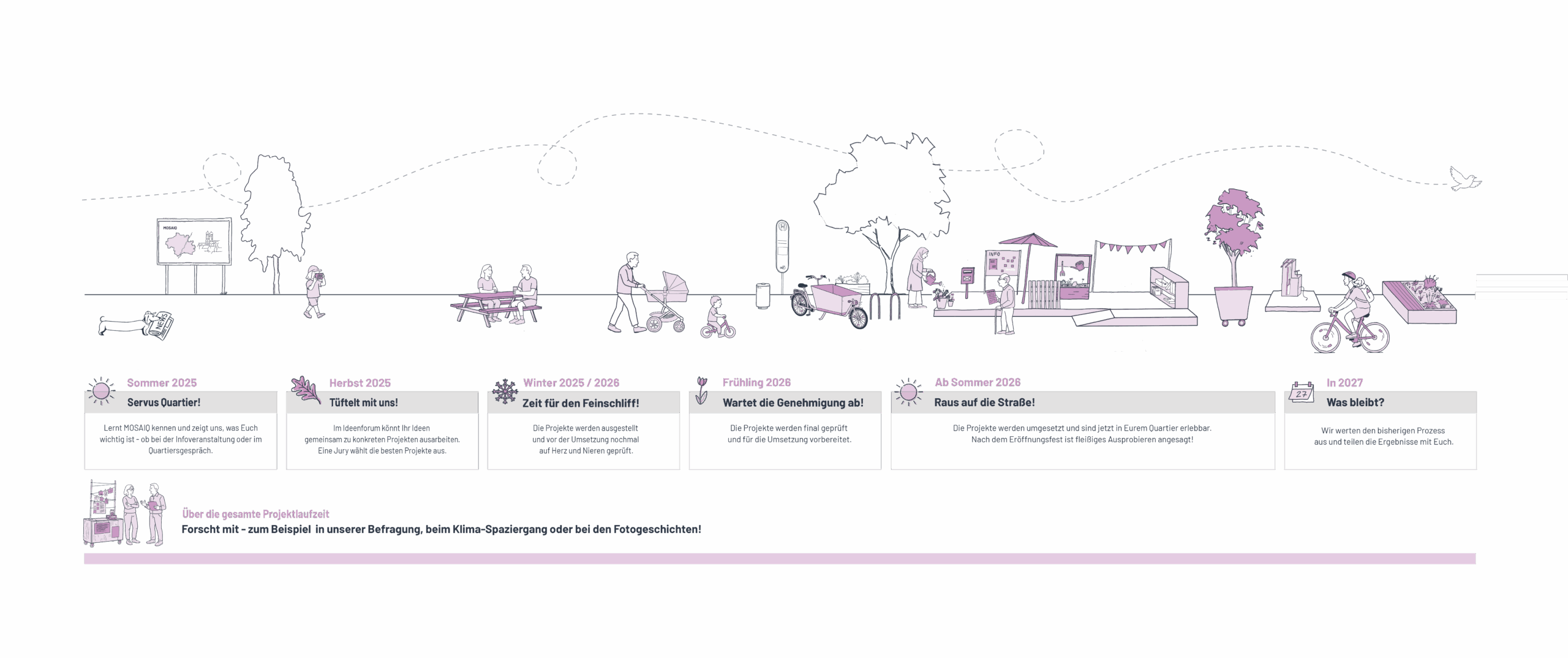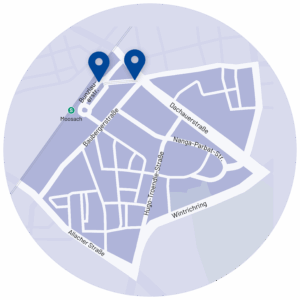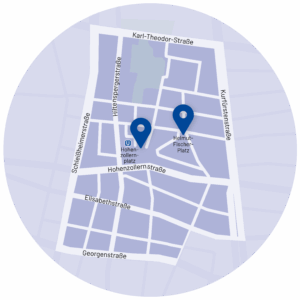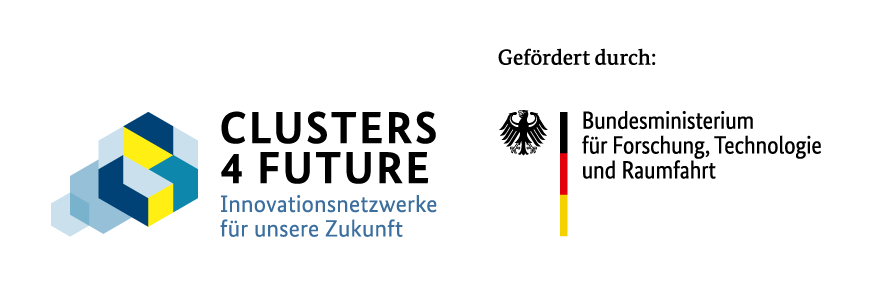Join in
MOSAIQ lives from your participation!MCube MOSAIQ thrives on the participation of everyone in the neighborhood. There are many different ways to get involved in various formats - every contribution is important. Together, we can develop solutions that meet as many different needs of local residents and stakeholders as possible
You live in the project neighborhoods in Schwabing-West or Moosach and would like to take part in MOSAIQ? Then you've come to the right place - here you'll find our participation offers for you!
Do you think the MOSAIQ project is great and don't live in Schwabing-West or Moosach? On this page you will soon find more ideas and instructions on how you can do something for the climate, togetherness and sustainable mobility as an individual, as an organized group, as a business or as a property owner.
In the MOSAIQ Ideas Forum, ideas for tangible, temporary projects for the public (street) space in the project districts are developed together. Over a period of several months to a year from summer 2026, individual jointly developed projects for the redesign of public (street) space in the project districts will be realized. Moosach and Schwabing-West implemented.

The call for ideas is now over and the first project forge has already taken place, namely in Moosach on 25.10.2025. The second project forge in Schwabing-West will take place on 15.11.2025. In the project forge, the valid ideas from the call for ideas will be further developed into project outlines in small groups and with the support of experts.
After the Project Forge, a jury evaluates which project outlines are particularly convincing according to defined criteria and compiles a selection. As soon as the project outlines have been selected, they are presented to the public at a closing event. The closing event marks the end of the ideas forum.
The jury's selection will be passed on to the MOSAIQ consortium, where it will be adapted, further developed and finally checked for feasibility. The implementation of the selected project outlines is then dependent, among other things, on successful approval and the consent of the responsible political bodies.
We look forward to your creative ideas and your active participation!

In this phase, you can get to know the MCube MOSAIQ innovation project. What is it about? What do we want to achieve (together)? And, of course, we want to get to know you and your neighborhood even better. Let us know what is important to you - whether at the information event or on site in a neighborhood meeting. Our team will be out and about a lot to talk to you.
The Ideas Forum is about jointly developing ideas for tangible, temporary projects for public (street) space. Individual projects will be implemented over a period of several months to a year from summer 2026. The ideas submitted can range from small (e.g. a seating area or raised bed) to large (design of a neighborhood square or temporary redesign of a street). Several small and medium-sized projects as well as one large project can be implemented - depending on the type of ideas submitted. The exact rules and conditions of participation will be communicated at the start of the ideas forum.
This is how the ideas forum works:
We look forward to your creative ideas and your active participation!
The winning projects from the ideas forum will be exhibited and extensively examined again before being implemented for a limited period of time. For example, the question is how the places in the neighborhood that have been redesigned based on your projects should be used.
The projects are finally reviewed and prepared for implementation.
Selected projects will now be implemented for several months to a year - depending on the ideas developed - and can be experienced in your neighborhood. A festival will be held to mark the start of the projects. Everyone is cordially invited to visit the new locations and try out different uses. We also want to know: Which of the implemented projects do you particularly like? Where could something be adapted?
This phase is primarily concerned with evaluating the feedback from participation and the research results. Recommendations for the long-term design of the project neighborhoods can be derived from this. Which implemented ideas were successful? Where are other solutions needed? We will share the results with you. The recommendations can also be transferred to other neighborhoods.
Since September 2025, two dialog points have been set up in both project districts as central contact points in public spaces. Here you can find out about dates, plans, participation opportunities etc., talk to the project team and give feedback.
Locations of the dialog points in Moosach:
Bunzlauer Straße, corner of Breslauer Straße
Bunzlauer Straße, corner of Dachauer Straße

Locations of the dialog points in Schwabing-West:
Hohenzollernplatz
Helmut-Fischer-Platz

Since the information event in July 2025, the project team has been on site regularly to find out: How do you get around? How do you spend time in your neighborhood? What do you want your neighborhood to look like in the future? Which places do you already like and why? Where would you like to change something?
You can find the latest dates for the neighborhood talks at mcube-cluster.de/mosaiq in the "Events" section.
The Ideas Forum is about jointly developing ideas for tangible, temporary projects for public (street) space. Individual projects will be implemented for a limited period of several months to a year from summer 2026. The ideas submitted can range from small (e.g. a seating area or raised bed) to large (e.g. a neighborhood square or a temporary redesign of a street). Individual small and medium-sized projects and one large project can be implemented. The final number depends on the ideas submitted. The exact rules and conditions of participation will be communicated at the start of the ideas forum.
How it works Ideas forum from:
We look forward to your creative ideas and your active participation!
Are you wondering how your comments, concerns, suggestions and ideas are taken into account in MCube MOSAIQ? Then take a look at HERE over!
We want to know how you experience your neighborhood - before, during and after the implementation of the temporary projects. That is why we are conducting surveys at all three points in time. For example, we want to know about the climate in the neighborhood, the quality of your stay, how you get around and how you feel about neighborhood cohesion.
All households in the project area will receive a letter in good time with information on how to take part. Anyone aged 16 and over can take part - simply online or at our on-site appointments. We will also be happy to help you fill out the survey there.
With the help of an app, we accompany a small group of participants from the neighborhood as they search for a parking space in their everyday lives - before and during the measures in the neighborhood. We are particularly interested in: How long does it take to find a parking space? How often do people search? And does the search for a parking space change as a result of the new measures? The app helps us to systematically record parking search traffic and answer these questions better - anonymously and in compliance with data protection regulations, of course. Participation is voluntary. All residents in the neighborhood with a car can take part, especially those without their own parking space. Recruitment takes place via our participation formats and communication channels.
The aim of the simulator study is to find out how intersections can be designed so that cyclists are safer on the road. To this end, tests are being carried out in a driving simulator at the University of the Federal Armed Forces in Munich, i.e. in a virtual road space. This involves testing how different variants of intersections influence the behavior of cyclists and motorists. In addition to actual safety, we are also investigating how safe cyclists feel and whether they perceive the distribution of space between cars and bicycles to be fair. The results should help to develop concrete recommendations for safe and fair traffic planning.
During the climate walks, we walk through the neighborhood together and use sensors to collect microclimatic data, for example on air temperature and wind speed. At the same time, we are interested in how you subjectively feel there - whether it is pleasant or rather too hot. This gives us a better picture of how the climate is perceived in different places in the neighborhood.
In the photo stories, children and young people take photos to record what they like about their neighborhood and what bothers them. We then talk together about their impressions, wishes and ideas for their neighborhood. In this way, they themselves become researchers of their surroundings. We also use photo stories during the temporary measures to find out together with the children and young people how they experience the changes - what works well and what they think is still missing.
As part of project weeks or final theses, students from the Technical University of Munich (TUM) accompany MCube MOSAIQ and collect and analyze data in the neighborhood.
The students talk to people in the neighborhood, observe the surroundings or evaluate data - depending on the questions they are researching.
In the Virtual Quarter, we show you some of the projects and future ideas developed in the Ideas Forum that can be implemented for a limited time - digitally, vividly and very easily on your smartphone. You will see realistic 3D views that you can use to look around the future district. This gives you a feel for how the different variants could look.
We also use other formats to investigate changes in the neighborhood and beyond. For example, we have noise measurements, a traffic survey and a microclimatic simulation carried out. We also observe how the public spaces are used: Who spends time where and how does this change over the course of the project? In addition, we talk to various stakeholder groups in interviews and group discussions (so-called focus groups) to gain an even better understanding of their experiences and perspectives.
Please also have a look at the general MCube Glossary here is a selection of terms and topics,
that may be of interest to you in the context of MOSAIQ.
E-Mail: mosaiq@mcube-cluster.com
By telephone: Mondays from 9-11 a.m.
under 01575 - 6400400

What is MOSAIQ?
Imagine something: There is more space for people. The streets have more trees and plants. Everyone can get around better. That's how your Schwabing-West district could be in the future. How would you like your district to be? We want to talk to you about it!
The project is called MOSAIQ. MOSAIQ is a research∙project. MOSAIQ means: Mobility and urban climate in the future city∙part. The Technical University of Munich is leading the project.
What is MOSAIQ about?
MOSAIQ wants to make the streets in the city∙part more beautiful. People should feel comfortable there. There should be more space. For meetings and plants, for example. You can help decide what is tried out in the Stadt∙teil. The ideas come from you. Some ideas will be tried out on the streets for a certain period of time.
The aim of MOSAIQ is to make urban districts good places to live.
At the same time, the climate in the city should improve. And people should be able to move around the city easily.
What is happening in the district?